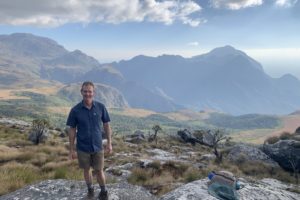For American physicians of my generation, working in global health is uncommon. My path began in medical school, went into hibernation for 21 years, and reemerged when I was 47 years old.
I spent most of my formative years in the Midwest. My paternal grandparents lived slightly north of Chicago. I have fond memories of driving through the city to reach their home. My sister and I sat silent in the back of our family’s long aqua Pontiac station wagon as my father drove. My mother, always nervous, juggled a paper map and watched for Big City drivers. The downtown skyscrapers made a strong positive impression. The Windy City was the largest place I had ever visited. It was magic and mystery combined.
Leaving home at age 17, I attended a public university, worked hard and got good grades. When it was time to choose a medical school, it was easy. The Windy City called. I chose Loyola University, a private Jesuit institution. Decades previously my grandfather attended dental school at Loyola and spoke of it favorably. There was only one problem: money.
I was born into a middle-class family. My parents were unable to afford the costs of a private medical school education and in our world, borrowing all of that money would be crazy. So, to my friends’ astonishment I joined the US Air Force. The military paid my tuition and fees and provided me with a $610 monthly stipend. From this I paid for rent, food, and transportation. A roommate made it possible.
The Jesuits have a strong commitment to service, though I did not know what this meant when I applied to Loyola. There was no religious aspect to my medical education, but an overarching, faintly whispered theme was service to others less fortunate than oneself.
Medical school lasts four years and one’s final year is usually filled with electives divided into one month “rotations”. In the fourth year of our curriculum, Loyola offered a one-month rotation in St. Lucia, a beautiful Caribbean island. Each month, two students were sent to work at St. Jude’s Hospital, located on the island’s southern tip. The University paid for everything: airfare, accommodation, and food. When it came time to choose fourth year rotations, I thought strategically. Chicago’s winters are cold so why not break it up with a month in the tropics? I applied to go to St. Lucia in February and on the first of the month, 1988, flew down.
My hope is that if meaningful, cost-free international experiences are offered to trainees, more physicians will broaden their medical world view.
I had traveled a bit growing up (in the back of the aqua station wagon), spent a summer backpacking through Europe, but had never lived outside of the USA for so long. We got up early, had clinic from 7 a.m. to 3 p.m. in the cool of the day, and then biked to a nearby beach. The hospital had some resources, but not many. I learned how to perform an excellent physical exam, suture a wound, and take care of kids with sickle cell disease. It was terrific. The four weeks quickly over, I returned to Chicago tanned and enthusiastic.
For the next 21 years I joined the well-trodden path of Life in the United States. I finished my time in the military and got a job with a large multi-specialty medical group. I liked it but didn’t love it. Thinking a change of venue would make me happier, I resigned and got a similar job in a different city. Of course, it wasn’t any better. I was in my early 40s, seeing patients 5 days per week, and counting the years until retirement. Complacent and stuck in a working life I did not love, my professional life was spent trying to care for children with neurological problems, but I was not happy.
After two decades, this was no longer sustainable. I began volunteering for short intervals in India, annually working two or three weeks abroad. This allowed me, even when at home, to dream about a life that I was not living. Finally, even this was no longer enough to keep me sustained during the long months in the USA. In 2009 I resigned, sold my house and car, put all of my belongings in storage, and joined Médecins Sans Frontières/ Doctors without Borders (MSF). Was my changing my career path into global health directly tied to my experiences 21 years earlier in St. Lucia? Unclear, but what I do know is that this early medical school experience demystified the idea of living and working outside of the USA. I had done it before. MSF was simply a bigger and more intense experience. MSF changed my professional path, veering me into global health.
Currently, the challenge for me is how best to inspire the next generation of physicians to consider a similar, non-US work environment. Recent medical trainees seem more open to talking about global health than physicians of my generation. Many medical schools and residency programs offer non-US experiences, but usually trainees must pay the costs for these programs. In medical school, if I had been required to pay my expenses to perform a rotation in St. Lucia, I would not have done so. I had debts from my undergraduate education and was not interested in adding to the payments I would eventually need to make. Of course, for today’s medical students it is even worse. The average medical student graduates with $280,000 in debt. How many trainees who might follow my path, letting an international medical experience simmer for years before acting on it, will not do so because incurring even more debt is out of the question?
Since my arrival at Children’s National in Washington DC, I have met with the enthusiastic, friendly staff in Development, a pleasant euphemism for fundraising. Previously they asked me, if I were able to raise funds to support my work, what were my biggest priorities. I have three. First, we need a discretionary fund to pay for medical care for critically ill children who have diseases that are not enrolled in research projects. Second, Queen Elizabeth Central Hospital badly needs a new more powerful MRI scanner both for patient care and research (“Grateful” and “Tick Tock”). And, third, we need to find a way to allow medical students and residents to experience work outside of the USA without cost.
My hope is that if meaningful, cost-free international experiences are offered to trainees, more physicians will broaden their medical world view. Most will not enter global health, immediately if ever. But their minds will be opened. For some, the experience may incubate, awaiting renascence years or decades later.






